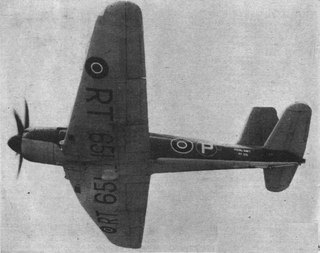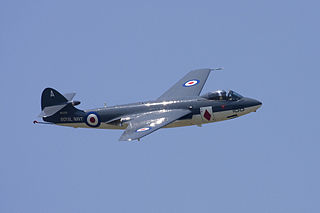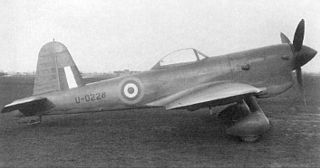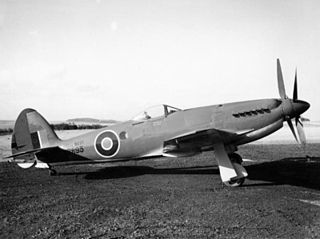 W
WThe Blackburn Firebrand was a British single-engine strike fighter for the Fleet Air Arm of the Royal Navy designed during World War II by Blackburn Aircraft. Originally intended to serve as a pure fighter, its unimpressive performance and the allocation of its Napier Sabre piston engine by the Ministry of Aircraft Production for the Hawker Typhoon caused it to be redesigned as a strike fighter to take advantage of its load-carrying capability. Development was slow and the first production aircraft was not delivered until after the end of the war. Only a few hundred were built before it was withdrawn from front-line service in 1953.
 W
WThe Blackburn B.48 Firecrest, given the SBAC designation YA.1, was a single-engine naval strike fighter built by Blackburn Aircraft for service with the British Fleet Air Arm during the Second World War. It was a development of the troubled Firebrand, designed to Air Ministry Specification S.28/43, for an improved aircraft more suited to carrier operations. Three prototypes were ordered with the company designation of B-48 and the informal name of "Firecrest", but only two of them actually flew. The development of the aircraft was prolonged by significant design changes and slow deliveries of components, but the determination by the Ministry of Supply in 1946 that the airframe did not meet the requirements for a strike fighter doomed the aircraft. Construction of two of the prototypes was continued to gain flight-test data and the third was allocated to strength testing. The two flying aircraft were sold back to Blackburn in 1950 for disposal and the other aircraft survived until 1952.
 W
WThe Boulton Paul P.92 was a British design by Boulton Paul for a two-seat, turret-armed, twin-engine heavy fighter and ground attack aircraft to meet Air Ministry Specification F.11/37. Only a half scale prototype – the P.92/2 – was built and tested as check on aerodynamics before the project was cancelled in 1940.
 W
WThe Bristol Brigand was a British anti-shipping/ground attack/dive bomber aircraft, developed by the Bristol Aeroplane Company as a replacement for the Beaufighter. A total of 147 were built and were used by the Royal Air Force in Malaya during the Malayan Emergency and Kenya until replaced by the de Havilland Hornet in Malaya and the English Electric Canberra jet bomber elsewhere.
 W
WThe de Havilland DH.103 Hornet, developed by de Havilland, was a fighter aircraft driven by two piston engines. It further exploited the wooden construction techniques that had been pioneered by the de Havilland Mosquito. Development of the Hornet had started during the Second World War as a private venture. The aircraft was to conduct long range fighter operations in the Pacific Theatre against the Empire of Japan but the war ended before the Hornet reached operational squadron status.
 W
WThe de Havilland Mosquito was a British light bomber that served in many roles during and after the Second World War. Mosquito-equipped squadrons performed medium bomber, reconnaissance, tactical strike, anti-submarine warfare and shipping attack and night fighter duties, both defensive and offensive. Mosquitos were widely used by the RAF Pathfinder Force, which marked targets for night-time strategic bombing. Despite an initially high loss rate due to low-level daylight attack operations, the Mosquito ended the war with the lowest losses of any of the aircraft types in RAF Bomber Command service.
 W
WThe de Havilland Vampire is a British jet fighter which was developed and manufactured by the de Havilland Aircraft Company. It was the second jet fighter to be operated by the RAF, after the Gloster Meteor, and the first to be powered by a single jet engine.
 W
WThe de Havilland DH 112 Venom is a British post-war single-engined jet aircraft developed and manufactured by the de Havilland Aircraft Company. Much of its design was derived from the de Havilland Vampire, the firm's first jet-powered combat aircraft.
 W
WThe Fairey Firefly was a Second World War-era carrier-borne fighter aircraft and anti-submarine aircraft principally operated by the Fleet Air Arm (FAA). It was developed and built by the British aircraft manufacturer Fairey Aviation Company.
 W
WThe Fairey Fulmar was a British carrier-borne reconnaissance aircraft/fighter aircraft developed and manufactured by aircraft company Fairey Aviation. It was named after the northern fulmar, a seabird native to the British Isles. The Fulmar served with the Royal Navy's Fleet Air Arm (FAA) during the Second World War.
 W
WThe Gloster Meteor was the first British jet fighter and the Allies' only jet aircraft to achieve combat operations during the Second World War. The Meteor's development was heavily reliant on its ground-breaking turbojet engines, pioneered by Frank Whittle and his company, Power Jets Ltd. Development of the aircraft began in 1940, although work on the engines had been under way since 1936. The Meteor first flew in 1943 and commenced operations on 27 July 1944 with No. 616 Squadron RAF. The Meteor was not a sophisticated aircraft in its aerodynamics, but proved to be a successful combat fighter. Gloster's 1946 civil Meteor F.4 demonstrator G-AIDC was the first civilian-registered jet aircraft in the world. Several major variants of the Meteor incorporated technological advances during the 1940s and 1950s. Thousands of Meteors were built to fly with the RAF and other air forces and remained in use for several decades.
 W
WThe Hawker Sea Fury is a British fighter aircraft designed and manufactured by Hawker Aircraft. It was the last propeller-driven fighter to serve with the Royal Navy, and one of the fastest production single reciprocating engine aircraft ever built. Developed during the Second World War, the Sea Fury entered service two years after the war ended. It proved to be a popular aircraft with a number of overseas militaries, and was used during the Korean War in the early 1950s, as well as against the 1961 Bay of Pigs Invasion of Cuba.
 W
WThe Hawker Sea Hawk is a British single-seat jet day fighter formerly of the Fleet Air Arm (FAA), the air branch of the Royal Navy (RN), built by Hawker Aircraft and its sister company, Armstrong Whitworth Aircraft. Although its design originated from earlier Hawker piston-engined fighters, the Sea Hawk became the company's first jet aircraft.
 W
WThe Hawker Tempest was a British fighter aircraft primarily used by the Royal Air Force (RAF) in the Second World War. The Tempest, originally known as the Typhoon II, was an improved derivative of the Hawker Typhoon, intended to address the Typhoon's unexpected deterioration in performance at high altitude by replacing its wing with a thinner laminar flow design. Since it had diverged considerably from the Typhoon, it was renamed Tempest. The Tempest emerged as one of the most powerful fighters of World War II and was the fastest single-engine propeller-driven aircraft of the war at low altitude.
 W
WThe Hawker Tornado was a British single-seat fighter aircraft design of World War II for the Royal Air Force as a replacement for the Hawker Hurricane. The planned production of Tornados was cancelled after the engine it was designed to use, the Rolls-Royce Vulture, proved unreliable in service. A parallel airframe that used the Napier Sabre engine continued into production as the Hawker Typhoon.
 W
WThe Hawker Typhoon is a British single-seat fighter-bomber, produced by Hawker Aircraft. It was intended to be a medium-high altitude interceptor, as a replacement for the Hawker Hurricane but several design problems were encountered and it never completely satisfied this requirement.
 W
WThe Martin-Baker MB 3 was a British fighter project with six 20 mm cannon. The fatal crash of the prototype led to the cancellation of the programme.
 W
WThe British Martin-Baker MB 5 was the ultimate development of a series of prototype fighter aircraft built during the Second World War. Neither the MB 5 nor its predecessors ever entered production, despite what test pilots described as excellent performance.
 W
WThe Miles M.20 was a Second World War fighter developed by Miles Aircraft in 1940. It was designed as a simple and quick-to-build "emergency fighter" alternative to the Royal Air Force's Spitfires and Hurricanes should their production become disrupted by bombing expected in the anticipated German invasion of England. Due to the subsequent shifting of the German bombing effort after the Battle of Britain towards British cities in what became known as The Blitz, together with the dispersal of British fighter manufacturing, the Luftwaffe's bombing of the original Spitfire and Hurricane factories did not seriously affect production, and so the M.20 proved unnecessary and the design was not pursued.
 W
WThe North American Mustang Mk.X was a British variant of the US North American P-51 Mustang using a Rolls-Royce Merlin engine in an experimental program undertaken by the Rolls-Royce company in 1942.
 W
WThe Supermarine Attacker is a British single-seat naval jet fighter designed and produced by aircraft manufacturer Supermarine for the Royal Navy's Fleet Air Arm (FAA). The type has the distinction of being the first jet fighter to enter operational service with the FAA.
 W
WThe Supermarine Seafang was a British Rolls-Royce Griffon–engined fighter aircraft designed by Supermarine to Air Ministry specification N.5/45. It was a further development of Supermarine's famous Spitfire and Spiteful aircraft, which by that point was a 10-year-old design following a rapid period of aviation development in history. It was outmoded by jet aircraft, and only 18 were built.
 W
WThe Supermarine Seafire was a naval version of the Supermarine Spitfire adapted for operation from aircraft carriers. It was analogous in concept to the Hawker Sea Hurricane, a navalised version of the Spitfire's stablemate, the Hawker Hurricane. The name Seafire was derived from the abbreviation of the longer name Sea Spitfire.
 W
WThe Supermarine Spiteful was a British Rolls-Royce Griffon-engined fighter aircraft designed by Supermarine to Air Ministry specification F.1/43 during the Second World War as a successor to the Spitfire. It had a new wing design, to improve its critical Mach number and allow safe operations at higher speeds. The new design also had a modern inwards-retracting undercarriage. Other changes included a larger fin to improve the somewhat marginal stability of Griffon Spitfires and changes to the mounting of the engine to tilt it down slightly for better visibility over the nose.
 W
WThe Rolls-Royce Griffon engine was designed in answer to Royal Naval specifications for an engine capable of generating good power at low altitudes. Concepts for adapting the Spitfire to take the new engine had begun as far back as October 1939; Joseph Smith felt that "The good big 'un will eventually beat the good little 'un." and Ernest Hives of Rolls-Royce thought that the Griffon would be "a second power string for the Spitfire". The first of the Griffon-engined Spitfires flew on 27 November 1941.
 W
WThe British Supermarine Spitfire was facing several challenges by mid-1942. The debut of the formidable Focke-Wulf Fw 190 in late 1941 had caused problems for RAF fighter squadrons flying the latest Spitfire Mk Vb. Rolls-Royce engineers were already working on a new version of the Merlin incorporating a two-stage supercharger; the combination of the improved Merlin and the Spitfire Mk VC airframe in a "stop-gap" design allowed the RAF to combat the Fw 190 on equal terms.
 W
WThe Vickers Type 432 was a British high-altitude fighter aircraft developed by the Vickers group during the Second World War. Intended to enable the Royal Air Force to engage the enemy's high-altitude bomber aircraft, it was to be armed with six cannons.
 W
WThe Westland Welkin was a British twin-engine heavy fighter from the Westland Aircraft Company, designed to fight at extremely high altitudes, in the stratosphere; the word welkin meaning "the vault of heaven" or the upper atmosphere. First conceived in 1940, the plane was built in response to the arrival of modified Junkers Ju 86P bombers flying reconnaissance missions that suggested the Luftwaffe might attempt to re-open the bombing of England from high altitude. Construction was from 1942–43. The threat never materialised; consequently, Westland produced only a small number of Welkins and few of these flew.